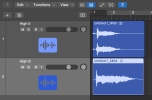sick pickle
Inspired
My S2 594 is setup perfectly. Basically factory specs. The guitar plays great...except for the High E bending up full on the 22nd fret. The note has a definitive cut off point where the sustain just dies. Unlike the B string, I can do a full bend on the 22nd fret and the sustain rings out much much longer.
The pickup heights are not too high. I have them at factory spec. Why would B sustain out on 22nd fret, but not high E? Other than changing the string itself, I am at a complete loss!
Here you can see the difference between High E bend and B string bend. The E just dies off and doesn't ring out at all.

Just changed the high E string for a new one...still getting the same thing. So looks like there is some issue with the guitar. Given that I am bending at the last fret, could there be something with the bridge? Even if I just puck the 22nd fret (no bend), it basically dies out the same way and sounds sort of 'microphonic' in a weird way.
Here is a sound sample. First note is the B string, plucked, 22nd fret - it resonates and rings out. Second note is the high E, 22nd fret, plucked. I repeat this one other time.
Setup - Fractal FM9 using a Soldano 100 head with delay type tone.
Any ideas?
The pickup heights are not too high. I have them at factory spec. Why would B sustain out on 22nd fret, but not high E? Other than changing the string itself, I am at a complete loss!
Here you can see the difference between High E bend and B string bend. The E just dies off and doesn't ring out at all.

Just changed the high E string for a new one...still getting the same thing. So looks like there is some issue with the guitar. Given that I am bending at the last fret, could there be something with the bridge? Even if I just puck the 22nd fret (no bend), it basically dies out the same way and sounds sort of 'microphonic' in a weird way.
Here is a sound sample. First note is the B string, plucked, 22nd fret - it resonates and rings out. Second note is the high E, 22nd fret, plucked. I repeat this one other time.
Setup - Fractal FM9 using a Soldano 100 head with delay type tone.
Any ideas?
